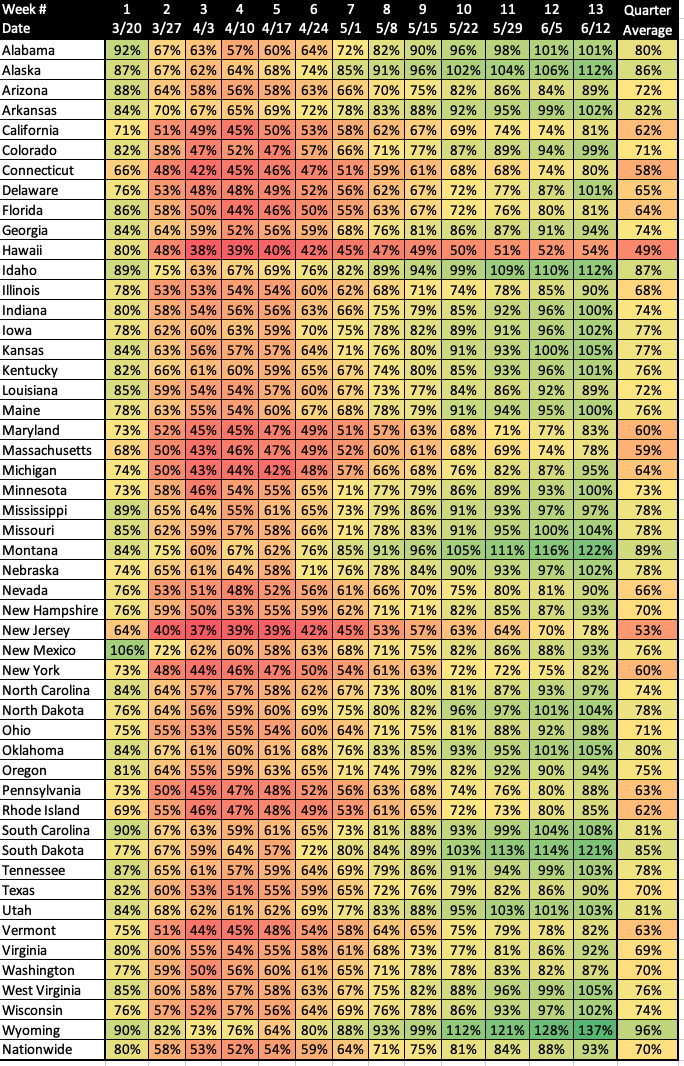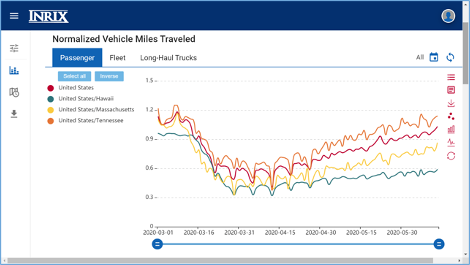
This is the 13th edition of a weekly review of changes in road traffic demand in the United States from the COVID-19 virus spread and our collective response.[1] We will endeavor to publish this Synopsis every Monday for the foreseeable future, providing results through Friday of the previous week. If interested in detailed information with daily updates, we have introduced the INRIX Trip Trends.
Key Findings
Overall travel continued to increase in Week 13, despite Tropical Storm Cristobal impacts
Nationally, when compared to typical travel,[2] Week 13 (Saturday, June 6 – Friday, June 12) saw:
Travel decline leaders in Week 13:

Figure 1
Background
Our incoming data sources (The ‘INRIX Fleet’) provides anonymous speed/location reporting to us in real-time and generates over 100 million trips, traveling over 1 billion total miles per day across the US. The INRIX Fleet provides information about all roads in the national network, not just major roads and spans the full range of vehicle types: consumer vehicles, local fleets, long haul trucks. We have re-purposed our INRIX Trips metadata – with only a 48-hour lag – to generate relevant summary level information about traffic demand.[3]
Synopsis
It has been thirteen weeks, more than a quarter of a year, since travel began its noticeable decline nationwide. Figure 1 shows the relative change in passenger vehicle travel from March 1, relative to the comparable day of the week during the control week of February 22 – 28, 2020. Figure 1 also includes a weekly rolling average. Passenger travel continued to trend upwards, down 7% weekly on Friday, June 12th, compared to 12% the previous Friday and 48% on April 9th the low point to date. The weekly average was last at 7% on Tuesday, March 17th, less than one week into the initial travel decline.
The daily figure for Friday, June 11th was 96%, a figure last seen on Friday, March 13th, the day nationwide travel decline began. Figure 2 shows the daily figures each week, illustrating the travel declines stabilizing in Weeks 4 and 5, increasing steadily since then.

Figure 2
State Level Passenger Travel increased in every state compared to last week, except for Louisiana and Mississippi, which had slight declines presumably due to Tropical Storm Cristobal. If not for Cristobal, this would have been the eighth week in a row all states had increased personal travel. Table 1 shows weekly levels by state for all 13 weeks since initial travel declines. Overall for the quarter, a net 30% drop in personal travel occurred nationwide compared to the Control Week.

Table 1 – Weekly Average Personal Travel by State – % of Control Week Travel
22 states now have personal travel exceeding the Control Week, up from 10 in Week 12. Only four states have travel declines still exceeding 20%: Hawaii (46%), New Jersey (22%), Massachusetts (22%), and Connecticut (20%). Delaware had the largest weekly increase in personal travel (14%). Louisiana (2%) and Mississippi (1%) were the only states with decreased travel week over week.
Nationwide Long Haul Truck travel held steady in Week 13, down 3%. 22 states now have long haul truck travel exceeding the Control Week. Only two states, Texas and New Mexico, still had a reduction of more than 10%, with both at 12%. Michigan, which for several weeks had been the most severely impacted state, was down 5% in total in Week 13, largely recovered from a peak reduction of 38% on April 16th.
Metropolitan Area[4] personal travel increased overall again this week, with 91 of the 98 metropolitan areas tracked increasing in Week 13. Only seven southeastern areas led by Mobile, Alabama had decreases, surely as a result of Cristobal. Twelve areas have now fully ‘recovered,’ up from six areas in Week 12. Personal travel has increased 27% or more from peak reduction level for all 98 metropolitan areas, except for Honolulu which has ‘improved’ 22%.
The ten largest reductions in travel in Week 13 were:
Orlando: 31% (36% last week)
San Francisco: 31% (38% last week)
Honolulu: 30% (33% last week)
Miami: 29% (34% last week)
New York City: 28% (35% last week)
Fort Myers: 26% (29% last week)
New Orleans: 26% (19% last week)
Washington, DC: 25% (30% last week)
Los Angeles: 21% (29% last week)
San Diego: 21% (28% last week)
Local fleet traffic in metropolitan areas held steady in Week 13 overall, at 2%.
Seasonal Adjustments
According to the Federal Highway Administration, the average daily national vehicle miles traveled in June 2019 was 16.5% higher than the daily average in February 2019.[5] The 7% reduction in nationwide personal travel actually understates the true change in expected travel. To simplify, for every 93 miles traveled in the US last week, we could have expected 116.5 miles if not for the virus. Thus, the 7% reduction translates into a roughly 20% reduction, seasonally adjusted. This calculation is included for illustrative purposes and to remind readers that, depending upon when the indices shown in this Synopsis return to ‘normal’ compared to the Control Week, they may or may not indicate full recovery on a seasonally adjusted basis.
When looking over the full ‘quarter’ of travel decline, overall seasonal trends would have led to a roughly 14% increase in travel from the Control Week. As noted in Table 1, the absolute decline in personal travel was 30% overall. In seasonal adjustment terms, this translates to nearly a 39% decline in total personal travel ‘VMT’ over the 13 weeks.
INRIX Trip Trends Dashboard Chart of the Week
Each week going forward, the Synopsis will include a chart from the INRIX Trip Trends Dashboard, a service available for licensing. Figure 3 shows the trends in daily passenger travel for the US (red), and three specific states: Hawaii (consistently the largest reduction), Massachusetts (a proxy for hard hit states), and Tennessee (the largest state by population that has returned to pre-COVID levels).

Figure 3
[1] Previous Issues can be found on the INRIX Blog site
[2] Given the day of week pattern of travel demand, we compare a given day and area to the same day/area in a previous week, and we are using the week commencing Saturday, February 22, 2020 as our ‘control week’
[3] Metadata used is total trip distance of all INRIX Trips originating in the country/state/region each day
[4] INRIX has established 98 metropolitan area geographies for internal purposes; these are the areas used in this analysis
[5] https://www.fhwa.dot.gov/policyinformation/travel_monitoring/tvt.cfm
To learn more about the data behind this article and what Inrix has to offer, visit https://inrix.com/.







Sign up to receive our stories in your inbox.
Data is changing the speed of business. Investors, Corporations, and Governments are buying new, differentiated data to gain visibility make better decisions. Don't fall behind. Let us help.







Sign up to receive our stories in your inbox.
Data is changing the speed of business. Investors, Corporations, and Governments are buying new, differentiated data to gain visibility make better decisions. Don't fall behind. Let us help.